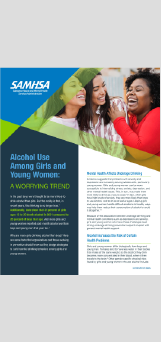Alcohol
We know that drinking too much can harm your health. The Dietary Guidelines for Americans recommends that if adults (age 21 and older) choose to drink alcohol, drinking less is better for health than drinking more.
There is no known safe amount of alcohol use during pregnancy or while trying to get pregnant.
What is a Standard Drink?
- 12 ounces of beer (5% alcohol content).
- 8 ounces of malt liquor (7% alcohol content).
- 5 ounces of wine (12% alcohol content).
- 1.5 ounces or a “shot” of 80-proof (40% alcohol content) distilled spirits or liquor (e.g., gin, vodka, rum, tequila, whiskey, brandy).
What is Excessive Drinking?
Signs of Drinking Too Much:
- You drink more or longer than you intended.
- You try to cut down or stop drinking, but are not able to.
- You need to drink more than you once did, to get the effect you want.
- You continue to drink even though it makes you feel depressed or anxious ― or adds to another health problem.
- Loved ones or trusted friends have made comments about your drinking.
- You spend a lot of time drinking or thinking about alcohol.
- You find that drinking interferes with daily activities, family, friends, or work.
- Or maybe…
- You have had legal problems due to drinking.
- You have experienced symptoms of withdrawal when you don’t drink (such as shakiness, sweating, tremors, headaches, anxiety, irritability, and/or insomnia).

Screen4Success
Screen4Success
A 10-minute screening to look for signs of risk in yourself, your child, or someone you care about. Find it on the free “Talk. They Hear You.” app.
Check Your Alcohol Use
- Set a daily and weekly drinking limit.
- Write down your limit and keep it with you.
- Record how much you drink each day.
- Avoid situations and triggers that cause you to drink.
- Ask a friend to help you stay within your limit.
- Talk with a doctor about your alcohol use.
Treatment
There is treatment. It varies, based on a person’s needs. There are many choices today. Treatment can include counseling, medications, and/or mutual-support groups.
Alcohol Policies
Policies with the strongest evidence of reducing alcohol misuse and related harms are:
- Regulating alcohol outlet density
- Minimum legal purchase age
- Limiting days or hours of sales
- Increasing alcohol taxes
- Minimum pricing
- Limiting alcohol advertising and marketing
- Dram shop (commercial host) liability laws
Learn about your state’s underage drinking prevention efforts and laws ― by reading your state’s report.
Resources
Individuals and Families
- Rethinking Drinking
- Rethinking Drinking Booklet (PDF | 2.3 MB)
- Check Your Drinking. Make a Plan to Drink Less.
- How to Start Drinking Less
- Alcohol and You: An Interactive Body
- Alcohol Use and Your Health
- Cancer Causes and Prevention: Alcohol
- Cancer Prevention and Heart Health ― What Role Does Alcohol Play?
- Treatment for Alcohol Problems: Finding and Getting Help
- Alcohol Treatment Navigator
Parents and Caregivers
- Talk. They Hear You.®
- What Parents are Saying
- Consequences of Underage Drinking
- What You Can Do to Prevent Your Child from Drinking Alcohol or Using Other Drugs (PDF | 600 KB)
- Why You Should Talk With Your Child About Alcohol and Other Drugs (PDF | 889 KB)
- Why Small Conversations Make a Big Impression
- Talking with Teens about Alcohol and Other Drugs: 5 Conversation Goals (PDF | 9.8 MB)
- Talking with Your Child about Alcohol: Keeping Your Kids Safe (PDF | 1.2 MB)
- Talking with Your Teen about Alcohol: Keeping Your Kids Safe (PDF | 1.1 MB)
- Age-Appropriate Conversations about Alcohol and Other Drugs (PDF | 486 KB)
- Impaired Driving: Talk With Your Kids (PDF | 722 KB)
- Be Prepared to Have the Difficult Conversation
- Getting Ahead of a Problem
- After High School: Talking With Your Young Adult About Underage Drinking
- Talking With Your College-Bound Young Adult About Alcohol
- Helping Girls and Young Women Stay Healthy by Avoiding Alcohol
Teens
Community Members and Practitioners
- Community Preventive Services Task Force Recommendations
- The Healthcare Professional’s Core Resource on Alcohol
- Take Action to Prevent Underage Alcohol Use (Available in Spanish)
- Prevent Unsafe Drinking Behaviors on Campus (PDF | 1.3 MB)
- Learn the Law: How Does Your State Prevent Underage Drinking?
- Turning Data into Action: A User’s Guide to the Report to Congress on the Prevention and Reduction of Underage Drinking
- Interagency Coordinating Committee on the Prevention of Underage Drinking
- National Institute on Alcohol Abuse and Alcoholism
- Alcohol Policy Information System (APIS)
- Alcohol-Related Disease Impact (ARDI)
Find more resources on alcohol use and misuse on the SAMHSA Store.
Need Help?
For mental or substance use disorders, call SAMHSA’s National Helpline at 1-800-662-HELP (4357) or TTY: 1-800-487-4889, or text your zip code to 435748 (HELP4U), or use the FindTreatment.gov to get help.




